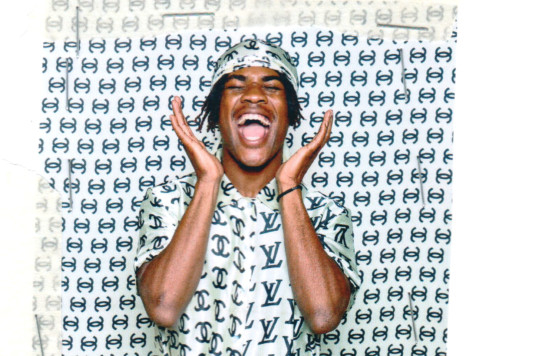
“A big part of our process is subverting the seductive power of branding and advertising,” says Christopher Benton. The Dubai-based creative director from Virginia, US, is one half of the collective behind Ghetto Majlis at the Sikka Art Fair 2017. “The irony that the majlis represents, its commentary on modern consumption is obvious and very tongue in cheek.”
The purpose of the (Ghetto) Majlis remains true to original intent — bringing people together, facilitating conversation and making friends out of strangers. It is in the counterfeit double C Chanel fabric that the space is gloriously decked in, that the recontextualised social statements emerge.
For this installation, three icons are explicit: the conceptualist Tom Sachs, the pop artist Hassan Hajjaj and Dapper Dan — a Harlem-based designer who made clothes for LL Cool J and Salt N’ Peppa in the 80s, he was the first person to ever put luxury brands in the context of street wear. Today, while the Drakes and Nicki Minajs dripping in Cartier and Dolce is de rigueur, it was Dan putting French luxury houses in the context of hip-hop culture that eventually made the revered brands sit up and recognise the emblematic power of the hip-hop community.
“Dynamic visuals and sounds can create memories and different experiences depending on the place, time or state of mind of a person,” says Salem Rashid, the Emirati/Greek, Producer, Benton’s creative partner and the founder of the UAE-based record label Bedouin Records, and its subsidiary Bastakiya Tapes. “I release music that I believe is the sound of ‘now’; it’s a raw and distorted sound that represents today’s lifestyle but there are also romantic and melodic moments that appear at times.” Set to Rashid’s beats, the majlis represents the very values in the third dimension.
Custom, site-specific music combines sounds from Bedouin Records artists, field recordings from the Satwa and Bastakiya neighbourhoods, local Yowla music, and ghettohouse from Detroit to create a sound matrix that juxtaposes the East and West and the traditional with the contemporary.
It is important here, that I stress, the duo does not support counterfeit luxury and the Ghetto Majlis is anything but an endorsement of it. “A year ago, I hosted a workshop to determine which brands children could recognise just by looking at logo alone. Chanel was the only brand that every single child knew,” says Benton of the satirical use of the coveted logo. “We could never appropriate from Chanel because they have much more power than we do.”
By rendering the logo a new context — one that it would never be associated in everyday life — the overall impact leans toward the fascinatingly absurd. Through exaggeration and repetition, the Ghetto Majlis renders the power of the logo meaningless. What is left is a new consciousness of branding and a seriously tricked out photo-op.
Don’t miss it
Sikka Art Fait is in Al Fahidi Historical District, Bur Dubai, and concludes on March 21.








